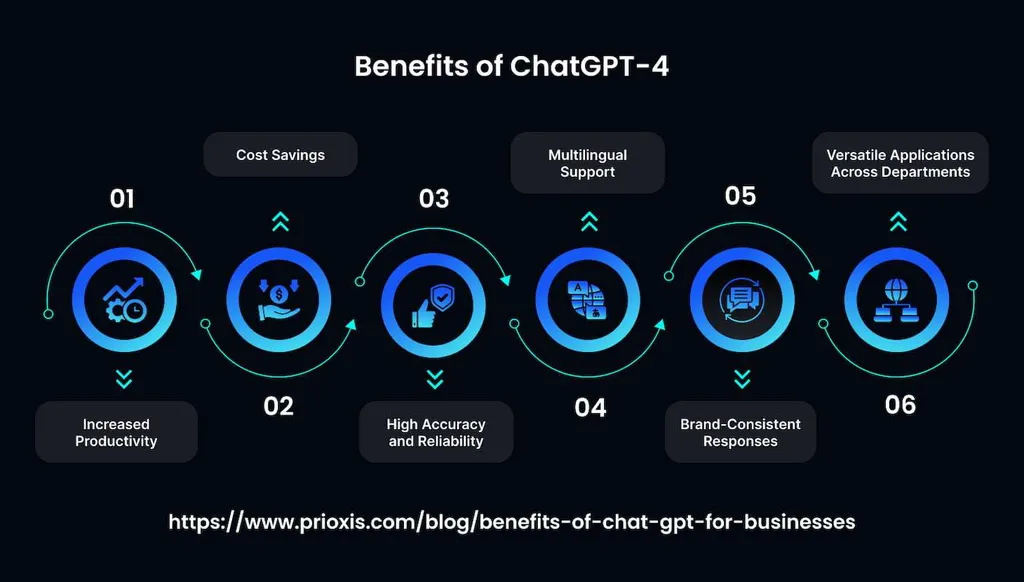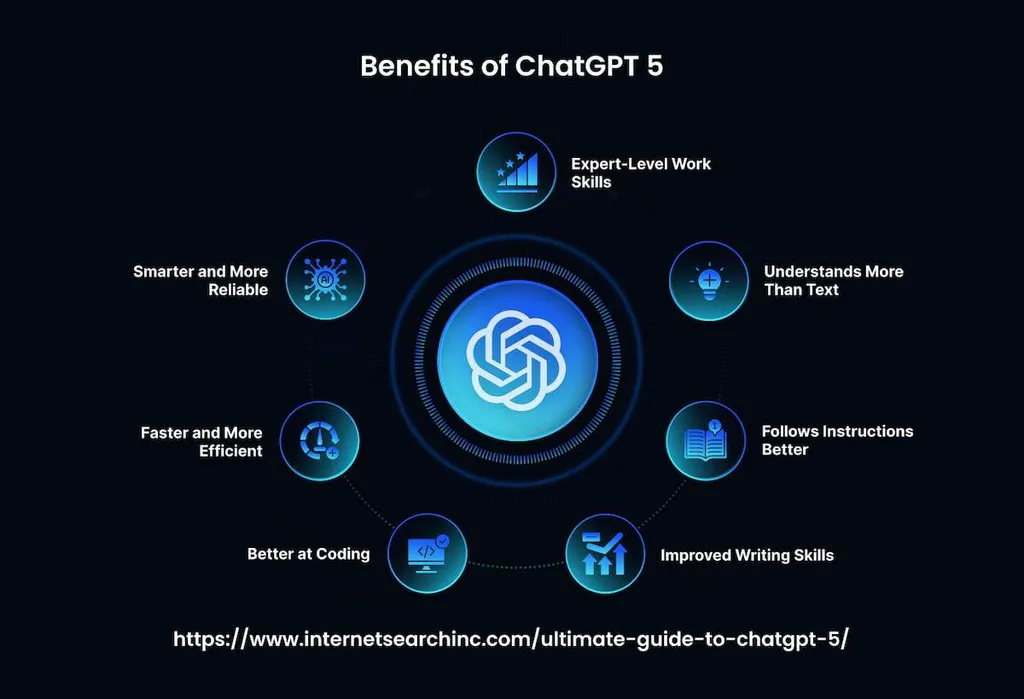The development of Artificial Intelligence (AI) technology resulted in the release of powerful GPT models. OpenAI built advanced solutions based on the principles of NLP. After the release of GPT-5, many critics started to assess its performance to see whether this version indeed had innovative functionality. Before choosing a suitable solution for your needs, consider what makes each model unique. In this guide, we compare Chat GPT 4 vs 5, including their core features, cost, and applications.
What is ChatGPT-4?
This Large Language Model (LLM) was released back in 2023. It stood out among other similar solutions due to its improved capacity to understand human language and generate relevant outputs. It expanded a list of the areas where AI can be potentially applied. Unlike previous versions, it was able to understand text inputs better. It had more growth parameters, which improved the accuracy of its replies. The LLM was designed to grasp the meaning of complex language nuances and produce coherent replies that were fully relevant to a specific context.
GPT-4 interpreted a context with accuracy and understood even the most complex instructions. As its algorithms became better, it started to create engaging, fact-based texts. The LLM was able to recognize subtle nuances and detect signs of discontent. Enterprises started using it in the areas where precision and understanding of contexts were especially important. It resulted in the development of chatbots, digital assistants, and other tools that were successfully applied across different industries.
The LLM had a significantly enhanced performance. Its ability to generate context-aware outputs and capacity to produce long-form content made it better than other algorithmic models. It was able to perform these tasks while maintaining consistency.
Undoubtedly, GPT-4 also had unprecedented problem-solving capacities and logical reasoning capabilities. Legal firms started to use AI bots to parse documents and discover relevant cases. Tech firms integrated such tools to generate documentation and tutorials. The LLM simplified the development of educational platforms designed to adjust learning experiences to a person’s needs. They provided accessible services for different audience segments. The model opened new opportunities for deploying AI tools across many fields and enabled enterprises to leverage the power of automation to streamline their workflows.
Key Features of GPT-4

This LLM became an important step toward better accuracy of AI models. Its impressive reasoning capacities made it useful in various areas. Here are the main strengths of this version:
- Augmented language understanding. It understands even the most challenging queries and maintains long conversations with users while demonstrating full coherence.
- Ability to perform various tasks. The version generates mistake-free code in different languages, summarizes texts, translates inputs, analyzes customer sentiment, and copes with creative writing tasks at a high level.
- Enhanced understanding of the context. The model is less likely to forget the conversation and can maintain a human-sounding dialogue during a prolonged session.
- Powerful reasoning capabilities. The LLM solves advanced math tasks and makes better decisions than its predecessor.
GPT-4 was adopted across many industries. It simplified customer service (CS) automation, software development, and text generation. After integrating it, enterprises spend less on debugging. Besides, it allows companies to provide support in multiple languages, simplify their creative workflows, and automate repeating tasks.
What is ChatGPT-5?
GPT-5 was launched in August 2025. This innovative AI model has impressive interpretation capabilities, can generate high volumes of quality content, and interact with users regarding a wide scope of issues. It surpasses the previous version and has augmented accuracy. Its sophistication is also on the next level, as it is suitable for a more extensive list of applications.
The LLM has more parameters than its predecessor. It translates into more professional text generation and multimodal processing capacities. When tasked with writing a poem, it uses more memorable metaphors and produces more impactful outputs with striking imagery. Besides, it answers questions without omitting any important details, and can solve specific tasks to ensure higher satisfaction.
According to developers, GPT-5 has top-grade research abilities and writes code at a professional level. Its area of applications is predicted to expand significantly in the coming years. It has already demonstrated high efficiency in customer support. The LLM delivers enhanced performance when solving tasks requiring a deep understanding of a situation and creative approaches.
GPT-5 has already been tested across multiple benchmarks. It was evaluated on its capacities in math, coding, and other tasks, including its ability to interpret visuals. The LLM has a significant edge over its competitors in most areas.
Due to a lower number of errors, it produces reliable outputs, solves problems with impressive consistency, and interacts with users in more engaging ways. GPT-5 grasps language subtleties and has an increased awareness of a conversation’s context. It draws information from multiple sources and engages in insightful conversations with users. In healthcare, it is predicted to improve diagnostics, facilitate the creation of personalized treatment plans, and foster research. In other industries, it is likely to speed up production workflows and foster innovation. GPT-5 has advanced data analysis capacities. It can offer valuable insights on multiple issues faced by humanity, including climate change, urban planning, and finance.
Key Features of GPT-5

The newly released LLM has improved speed, augmented reasoning capacities, and outstanding adaptability and configurability. Its performance can be adjusted to make it suitable for narrow use cases. The model has several notable upgrades:
- Larger context window. The LLM processes more text during an interaction with a user, conducts an in-depth analysis, and maintains more meaningful conversations.
- Improved reasoning. It solves more complex issues, including technical problems and legal queries. The model has a better capacity to analyze data and produces outputs with fewer errors.
- Shorter response times. GPT-5 generates replies faster and has reduced latency. It delivers enhanced performance on small devices or in distributed environments.
- Upgraded multilingual support. Users receive precise responses in their native language, making this version perfect for developing AI applications with global outreach.
- Top-grade domain expertise. Clients receive personalized answers when asking questions. It expands a list of the model’s applications. It can be used in healthcare, law, programming, media, and entertainment industries.
GPT-5 follows the instructions closely and creates outputs that answer user prompts and meet formatting requirements. It has high context awareness, uses resources efficiently, and can be applied in any industry to automate tasks and generate specialized outputs.
Chat GPT 4 vs 5: Which Model to Choose?
Before setting your mind on a specific version, consider its unique functionality and potential. Whether you want to build an AI-powered app, make algorithms a part of your workflow, or discover innovation opportunities, your choice will impact the profitability of your business.
We have outlined the key differences between these two versions in the table below:
| Comparison criteria | GPT-4 | GPT-5 |
| The number of parameters | About 1.76T | About 300B |
| Architecture | Transformer-based | Transformer and reasoning components from o1/o3 models |
| Context window | 8K-32K tokens | 400K |
| Notable capabilities | Highly coherent text outputs | Top-level reasoning, advanced logic, enhanced chain-of-thought processing |
| Performance | Resource-intensive | Optimized efficiency thanks to automatic routing |
| Hallucinations | A lower number than in GPT-3 | Augmented accuracy due to factuality training |
| Context understanding | Limited use in narrow situations | Impressive contextual depth and advanced reasoning |
| Memory | Remembers a conversation during a session | Upgraded context retention |
| Training | Extensive datasets | A variety of datasets with advanced filters. Relies on information published until September 2024. |
| Ability to execute tasks autonomously | Limited | Follows complex workflows |
| Configurations | Developers can adjust basic parameters | One can adjust multiple advanced controls and use custom features |
| Prices | $5-$60, depending on the version | $0.03-$10 |
GPT-4 was mostly used for content creation, code writing, customer service, and other tasks that can be automated. GPT-5 has already demonstrated higher effectiveness in these areas.
Main Reasons to Use GPT-5
While GPT-4 is famous for its ability to interpret inputs correctly in a relevant context, it still occasionally fails to solve complex queries. Besides, many users detected errors and hallucinations when using this version. In addition, the ability of this LLM to personalize conversations and make them sound human was also quite limited.
A brief Chat GPT 4 vs Chat GPT 5 comparison shows that the latter is a more appealing alternative, as it has an outstanding understanding of context and answers even the most challenging queries. It generates quality outputs with impressive consistency and has fewer errors. When conversing with it, users felt as if they were chatting with a real human. Its replies are empathetic and answer a person’s needs. Here are the most notable upsides of using the recent version:
- Advanced AI. GPT-5 understands prompts in human languages better and generates eloquent responses instead of sending generic replies. It adapts to evolving contexts and makes conversations personalized.
- Empathy. GPT-5 grasps the meaning of human emotions and uses a warm tone when empathetic responses are necessary. It allows virtual agents to establish meaningful connections with consumers, maintain discussions at an advanced level, and solve convoluted problems.
- Privacy. The data collected by the model during interactions with users remains strictly confidential.
- Customization. GPT-5 changes its responses depending on a particular user. It provides helpful recommendations and makes conversations engaging.
After juxtaposing Chat GPT 4 vs 5, one will notice that the latter delivers cost-effective outputs and has upgraded capacities. Enterprises need to hire experienced developers who specialize in the newest LLMs to implement AI solutions based on this version. They can also outsource the task of integrating such systems to Metadialog experts who develop custom LLMs designed to automate up to 87% conversations with customers. Get in touch with our team today and discover how to handle difficult queries at a lower cost and optimize your routines.
